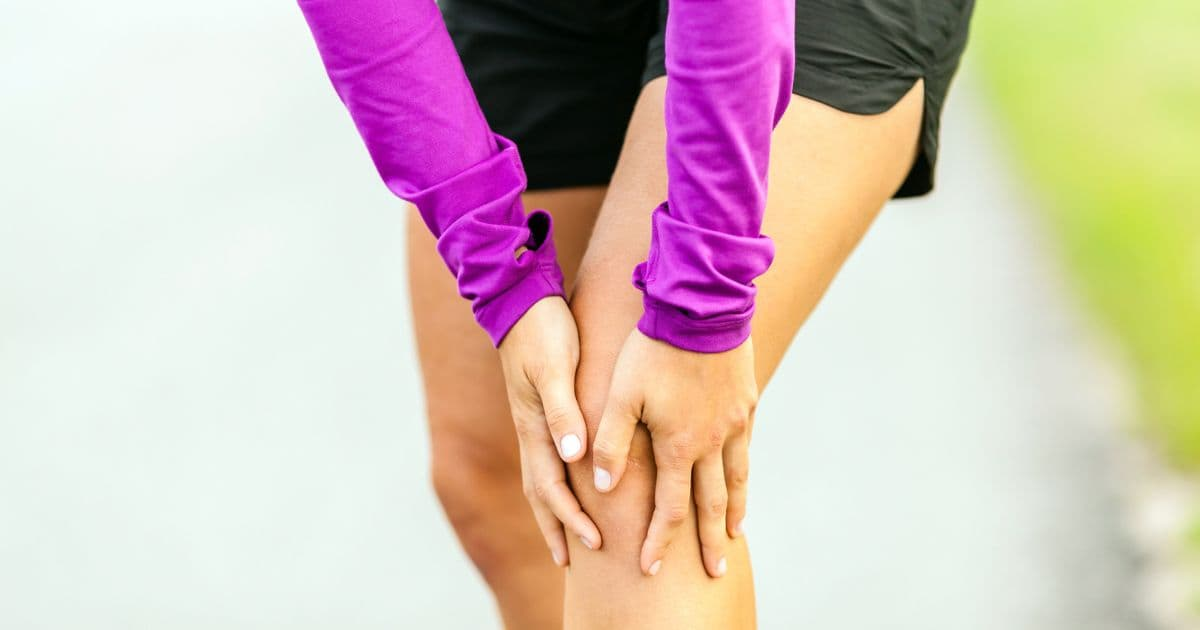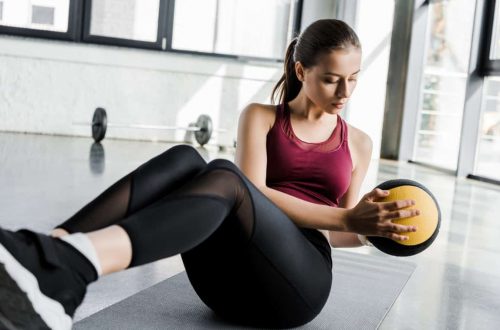How to Save Your Knees Without Giving Up Your Workout
Let’s face it, your knees are pretty incredible. They allow you to walk, run, dance, jump, and squat, all while supporting your body weight and handling the wear and tear of daily life. But if you’ve ever experienced knee pain or a knee injury, you know that it can put a serious damper on your workout routine. So if you’ve been wondering how to save your knees without giving up your workout or sacrificing your fitness goals, I have some nuggets of wisdom that will help!
**Disclosure: There are affiliate links in this article, which means that if you make a purchase after clicking on one, I may earn a commission. Full disclaimer here. **

Understanding Knee Anatomy and Function
First, let’s take a quick trip back to high school biology class (don’t worry, there won’t be a quiz) and talk about the basic anatomy of the knee. Your knee joint is comprised of the thigh bone, the shin bone, and the knee cap (also known as the femur, tibia, and patella). These bones work together in harmony, much like a well-orchestrated symphony, to provide smooth movement and stability.
Surrounding this bony trio are a number of ligaments, tendons, and muscles that provide knee joints with additional support and control. It’s important to understand that your knee is not just a simple hinge joint – it’s a complex piece of machinery that’s subject to a variety of forces during exercise.
Now that you’ve got a rough idea of what’s going on under the hood, let’s move on to some strategies for keeping your knees happy and healthy.
Common Reasons for Knee Pain
Knee symptoms are a common complaint that can stem from a variety of causes. Understanding the underlying factors can help you take appropriate action to address the issue and prevent further complications. Here are some common reasons for knee pain:
- Overuse and Strain: Repetitive movements and high-impact activities can lead to overuse injuries, causing inflammation, tendonitis, or muscle strains around the knee joint.
- Ligament Pain: Sudden twisting or impact can result in sprains or tears of the knee ligaments, such as the ACL, MCL, or PCL, which provide stability to the joint.
- Cartilage Damage: The menisci, which are the shock-absorbing cushions between your thigh and shin bones, can become damaged or torn from forceful twisting or wear-and-tear over time.
- Patellofemoral Pain Syndrome: Also known as “runner’s knee,” this painful condition occurs when the kneecap doesn’t move smoothly over the femur, causing pain and discomfort around the knee joint.
- Arthritis: Osteoarthritis, rheumatoid arthritis, and other forms of joint inflammation can cause knee pain, stiffness, and swelling, particularly in older individuals or those with a history of knee injuries.
- Bursitis: Inflammation of the bursae, which are small fluid-filled sacs that cushion the knee joint, can lead to localized pain and tenderness.
- Being Overweight: Carrying excess weight puts extra strain on your knees, leading to chronic pain and discomfort. Maintain a healthy weight to reduce stress on the knee.
By identifying the possible causes of knee pain, you can take the necessary steps to address the issue, seek appropriate treatment, and protect your knees for the long haul.
Taking Action: Consult a Professional
Don’t be shy about seeking a doctor’s help if you’re experiencing ongoing knee discomfort. A physical therapist, sports medicine specialist, or orthopedic doctor can assess your situation and help pinpoint the underlying issue, such as osteoarthritis, chronic inflammation, or damage to the cartilage and connective tissue.
During your consultation, be prepared to provide the doctor details about your workout routine, history of knee problems, and the specific symptoms you’re experiencing. This information will help the professional recommend appropriate physical therapy and adjustments to your exercise regimen, prescribe targeted strengthening exercises, or suggest other treatment options.
Adopting Proper Technique and Form
Just like a Hollywood star needs a good acting coach, you need to learn the proper form from a personal trainer to avoid putting a strain on your knees. Correct alignment and posture are the keys to keeping your knees happy during your workouts. Don’t let your knees play the role of a melodramatic diva – keep them in check with these tips:
- Keep your knees aligned with your toes: Whether you’re squatting, lunging, or doing the Charleston, make sure your knees are tracking in the same direction as your toes. Avoid the dreaded knee wobble – nobody wants to see that dance move.
- Don’t let your knees go too far forward: When squatting or lunging, avoid letting your knees travel too far past your toes. This can cause extra stress on the joint. Instead, focus on sitting back into the movement, as if there’s a chair behind you that’s just a little too far away.
- Mind the gap: If you’re doing standing exercises, keep a slight bend in your knees rather than locking them out. This will help prevent hyperextension and keep your joints healthy and spry, just like you!

Strengthening Key Muscles Around the Knee
You might be wondering, “What do my quads, hamstrings, and glutes have to do with my knees?” Well, these powerhouse muscle groups all play a role in supporting your knee joint, so it’s important to keep them strong and balanced. Think of them as the pit crew for your knees – they help keep everything running smoothly and efficiently.
To give your knees the support they need, make sure you’re incorporating exercises that target your quadriceps, hamstrings, glutes, and calf muscles into your workout routine. Some great workout options include:
- Quadriceps: Your quads are like the stage manager of your knee – they help control the movements and provide stability. Strengthen them with exercises like squats, lunges, and leg presses.
- Hamstrings: These bad boys are the understudy to your quads, providing support and balance. Make sure they’re ready for their close-up with exercises like hamstring curls, deadlifts, and glute bridges.
- Glutes: A strong, toned booty isn’t just for Instagram – it’s essential for knee joint health too! Your glutes help control your hips and legs, keeping your knees in line. Get them in shape with exercises like squats, lunges, and hip thrusts. (Need more help growing your glutes? You’ll definitely want to invest in a set of booty bands!)
- Calf muscles: Like a trusty sidekick, your calves help support your knees from below. Strengthen them with calf raises, seated or standing, to keep your knees in tip-top
Reap the Benefits of Low-Impact Workouts
Joint and arthritis-friendly workouts can help reduce the stress on your knees while still providing a fantastic workout. Not only do low-impact exercises help prevent injuries and arthritis, but they also improve cardiovascular health and can be modified to suit women of all fitness levels.
Examples of Knee-Friendly Exercises
Swimming: Dive into a pool and let the water support your body weight while you work out.
Cycling: Hop on a stationary bike (you can find affordable bikes for under $500 on Amazon) or take your mountain bike for a scenic ride through the park for a joint-friendly cardio workout.
Rowing: Channel your inner Olympian and glide through a full-body workout with minimal knee strain and stress. (I have a Concept2 rower, and it’s a total game-changer!)
Yoga: Unleash your inner zen and improve flexibility, strength, and balance. (Need a great yoga app? Check this one out.)
Cross Country Skiing: Enjoy the great outdoors and get an awesome workout without putting any strain on your knees.
Pilates: Strengthen muscles in your core, improve posture, and develop and maintain long, lean muscles without causing knee joint injury or pain.
Jogging: Although there is less supporting evidence that running can hurt your knees overtime, it can exacerbate a preexisting issue or imabalance. And while jogging isn’t zero-impact, it’s much easier on your knees than all-out running. Consider this alternative if you’re an avid runner suffering with knee pain.
Under-Desk Ellipticals: If you need something low-impact that you can do while you work, under-desk ellipticals are an excellent choice. (My favorite is the Cubii JR!)
Incorporate Low-Impact Exercises into Your Routine
Mix and match your favorite low-impact exercises with weights in your regular workout routine. Remember, variety in exercise is the spice of life, your muscles and your knees will appreciate the break!
Sole Mates: Protect Your Knee Joints with Proper Footwear
Did you know your shoes can either be your knees’ best friends or worst enemies? The right pair of shoes can provide support, stability, and shock absorption, which are essential for keeping your knees healthy and minimizing the risk of injury.
Types of Shoes for Different Workouts
Not all shoes are created equal. Here’s a quick guide to help you choose the right shoes for your workout:
- Running/Jogging: Opt for shoes with cushioning, support, and a comfortable fit. Remember, you’ll be pounding the pavement for miles, so treat your feet (and knees) well! (Can’t go wrong with ASICS.)
- Cross-training: Look for shoes with good lateral support and a stable platform for versatile workouts, like HIIT, weightlifting, and agility exercises.
- Hiking: Pick shoes with ankle support, sturdy soles, and water resistance to tackle those challenging trails.
- Dancing: Dancing footwear needs to stabilize your foot while staying lightweight. (These are my fav pair.)
Tips for Selecting the Right Shoe
To pick the perfect pair, keep these tips in mind:
- Know your foot type: Are you flat-footed or do you have high arches? The right shoe should cater to your unique foot structure.
- Prioritize support and cushioning: Look for shoes that provide ample support and shock absorption, especially in the heel and midsole.
- Replace worn-out shoes: Shoes lose their support and cushioning over time. Replace them every 300-500 miles, or when you notice significant wear and tear.
Bend, Don’t Break: Stretching and Recovery Techniques
Let’s talk about the magic of stretching during injury and recovery. You might be tempted to skip this part, but trust us—your knees will thank you for showing them some TLC. Stretching is crucial for maintaining flexibility, preventing injuries, and keeping those knees in tip-top shape.
Pre-Workout: Dynamic Stretching
Before you dive into your workout, it’s time for some dynamic stretching. Think of it as the opening act that gets your body ready for the main event. Dynamic stretches involve movement and help to loosen up your muscles and joints. Try incorporating leg swings, high knees, and hip circles to get your lower body warmed up and ready for action.
Post-Workout: Static Stretching
Once you’ve finished your workout, it’s time to cool down with a static stretch or two. This type of stretching involves holding a position for about 15-30 seconds, allowing your muscles to relax and lengthen. Focus on stretches targeting the quadriceps, hamstrings, calves, and hips to keep your knees limber and happy.
Roll With It: Foam Rolling and Other Recovery Methods
Don’t forget to show your muscles some love with foam rolling and other recovery techniques. Foam rolling helps release tight muscles and can work wonders for your knee health. Be sure to give some extra attention to your IT band, quads, and calves. Other recovery methods like massage, ice, and compression can also help save your knees and keep you ready for your next workout.
Listen Up: Monitoring Your Progress and Listening to Your Body
As you diligently work on keeping those knees healthy, it’s crucial to stay in tune with your body. Learning to recognize signs of potential knee issues and acting promptly can save you from more serious complications down the line. So, let’s dive into some key aspects of listening to your body and monitoring your progress.
Recognizing Warning Signs
While some discomfort might be expected during a strenuous workout, it’s essential to distinguish between the “good” and “bad” joint pain. Keep an eye out for these red flags that may signal potential knee issues:
- Persistent or sharp pain during or after exercising
- Swelling or inflammation around the knee joint
- Popping or clicking sounds when you bend or straighten your knee
- Feelings of instability or weakness in the knee
- Reduced range of motion or stiffness
If you notice any of these signs, it’s time to take a step back and reevaluate your approach.
Adjusting Your Workout Routine

Based on professional guidance or your own observations, you may need to modify your workout routine to address any knee concerns. Here are a few suggestions for making adjustments:
- Gradually increase the intensity, frequency, or duration of your workouts to avoid overloading your knees.
- Swap high-impact activities for low-impact alternatives, like cycling or swimming, to reduce stress on your joints.
- Prioritize strength training for the muscles surrounding your knees to provide better support and stability.
- Allocate more time for stretching and recovery, focusing on flexibility and mobility exercises.
Remember, exercising and taking care of your knees is an ongoing process. Stay vigilant in monitoring your progress, and don’t hesitate to make adjustments as needed. This proactive approach to exercise will help you enjoy your workouts while keeping your knees in great shape for years to come.
Conclusion
Now you know how to save your knees without giving up your workout! By understanding the ins and outs of knee anatomy, the possible causes for symptoms, mastering proper technique and form, flexing those supporting muscles, embracing low-impact workouts, lacing up with the right footwear, stretching like a pro, and keeping a keen ear to your body’s whispers, you’re well on your way to becoming a bona fide knee guardian.
So, go ahead, and conquer those workouts with newfound confidence, knowing that your knees have got your back (or, you know, your legs) every step, squat, and lunge of the way. Stay fit, stay fabulous, and treat those knees like the royalty they are!
FAQ:
To prevent knee injuries, focus on maintaining proper form and technique during exercises, strengthening the muscles surrounding your knee, incorporating low-impact activities into exercise, wearing appropriate footwear, and dedicating time to stretching and recovery.
Proper form varies depending on the exercise, but a few general principles include maintaining correct alignment and posture, engaging your core, and avoiding excessive pressure on your knees. Do a session or two with a personal trainer or watch instructional videos to learn the correct form for specific exercises.
If you have existing knee issues or want to minimize the risk of injury, it’s wise to avoid high-impact exercises like running or jumping. Instead, opt for low-impact activities such as swimming, cycling, yoga, or rowing, which are easier on your body and your knee joints anyway.
Don’t ruin your knees with the wrong shoes! Footwear plays a critical role in knee protection, as it provides support, cushioning, and stability. Choose shoes specifically designed for your chosen activity, and replace them when they show signs of wear.
For optimal knee health, incorporate both dynamic stretches (e.g., leg swings, high knees) before your workout and static stretches (e.g., leg press, hamstring stretch, quadricep stretch) afterward. Focus on the muscles surrounding your knee, like the quads, hamstrings, calves, and hips.
It’s important to distinguish between typical workout soreness and signs of a potential knee problem. If you begin to notice persistent or sharp pain, swelling, instability, popping sounds, or reduced range of motion, it’s time to reevaluate your workout routine and consult a professional to see if physical thearpy is needed.
There’s no one-size-fits-all answer, as individual needs vary. However, it’s essential to listen to your body and make adjustments as needed, such as incorporating more low-impact exercises, increasing strength training, or dedicating more time to stretching and recovery.





